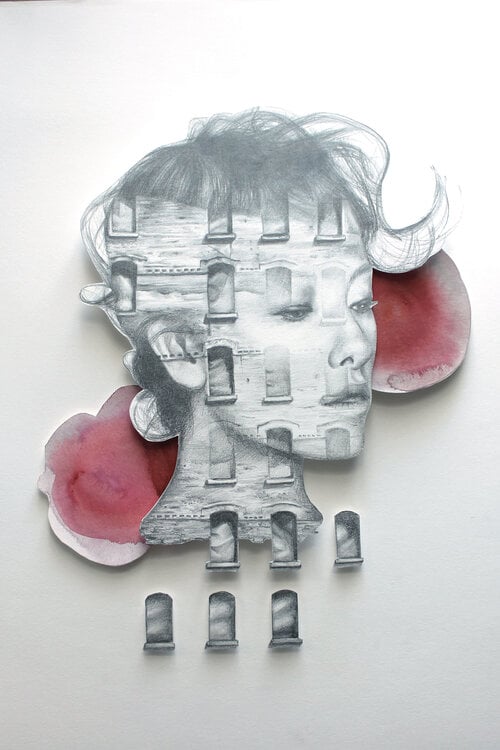The Korean-Canadian artist explores portraiture through drawing, painting, and layering paper.
Trying on styles is like trying on outfits, says Christine Kim. But truth is that this Korean-Canadian paper artist has long since found her own voice. Her creations explore portraiture through drawing, painting, cutting and collaging in a unique and intriguing way.
Kim has been drawing all her life, though she admits it took her a long time to understand the term “artist.” After taking art classes in high school, she graduated from Queen’s University with a degree in Fine Arts. She spent a few years working as a teacher but felt her artistic side waning, so she decided to pursue a Master’s degree in Art Education at the University of Victoria, also in Canada where she lives.
When she was asked to bring studio materials with her, she picked up anything that was portable: some pencils, a knife and some paper. Encouraged by her teachers, she slowly began to explore and experiment. For Kim, one of the biggest mistakes young artists make is to try to get commissions as soon as possible, which leads to them being pigeonholed with certain materials and techniques.
In terms of her creative process, the Korean-Canadian artist begins each of her collages with the figure, drawing inspiration from poses and gestures in fashion photography. She then arranges all the elements on her work table, and from there begins to mix and match them to find what fits, though she does not yet glue them down. Kim defines this process as a creative puzzle that needs to be solved.
Her paper artworks combine both the digital and the analogue. She uses Bristol paper – a special type of drawing paper made by gluing together several layers of card – and watercolour paper with a textured surface. She draws her designs with an iPad and then cuts them with a Silhouette Cameo cutting machine. For smaller cuts, she uses various precise and ergonomic scissors, as well as cutters and awls.
The result is delicate portraits that hover between the realms of illustration, collage and architecture, and which, in the artist’s own words, express fragility and complexity at the same time.
One of her most important works is ‘Paper Thin’, a series of drawings of a woman’s face surrounded by several layers of elements, such as floral wallpaper combined with wooden slats. A series of wrought iron-style headdresses crown each of the elegant silhouettes. The plants emerging through the crowns partially cover the face, but flowers nevertheless bloom around them.

Kim’s intention was to explore the tension between “concealing” and “revealing”, inviting viewers to participate in a play of rigidity and organic flow. These concepts are echoed in her series ‘At the End of All this Language’, which focuses on the silent and shy gestures of the body. The lace-like paper cut-outs represent a fence, through which the body tries to escape to find freedom.

The natural world, represented through leaves and flowers, is again present in her work ‘Fragmentary’. Faces peer timidly through them as if they were a kind of refuge. Hand-drawn pencil portraits are combined with masterfully cut, digitally designed botanical patterns.

Aside from portraits, Kim has also developed installations in which the visitor is immersed in a world of paper. In ‘Confessional’, for example, she explores the relationship between public and private spheres in contemporary society. To do so, she draws on the architecture of traditional sacred spaces such as the confessional.

On the other hand, in ‘Paper Orbs’ the public actively participates in an artistic parade along a route through various spaces. The star of the show is, of course, paper, folded according to the art of origami, in the form of sculptures, helmets, floats and more.

For Kim, the key to her ability to accumulate such diverse yet distinct works lies in having “zero days”. In other words, periods in which she has no classes, commissions or admin tasks, time which she can use to create freely and productively. Even when she has nothing to do, she likes to read a book, clean her studio or write in her sketchbook. She believes that inspiration exists, but it has to find you working.
*For more images:

